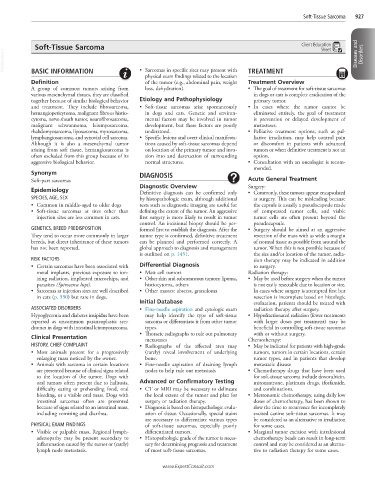Page 1846 - Cote clinical veterinary advisor dogs and cats 4th
P. 1846
Soft-Tissue Sarcoma 927
Soft-Tissue Sarcoma Client Education
Sheet
VetBooks.ir Diseases and Disorders
• Sarcomas in specific sites may present with
BASIC INFORMATION
physical exam findings related to the location TREATMENT
Definition of the tumor (e.g., abdominal pain, weight Treatment Overview
A group of common tumors arising from loss, dehydration). • The goal of treatment for soft-tissue sarcomas
various mesenchymal tissues, they are classified in dogs or cats is complete eradication of the
together because of similar biological behavior Etiology and Pathophysiology primary tumor.
and treatment. They include fibrosarcoma, • Soft-tissue sarcomas arise spontaneously • In cases where the tumor cannot be
hemangiopericytoma, malignant fibrous histio- in dogs and cats. Genetic and environ- eliminated entirely, the goal of treatment
cytoma, nerve sheath tumor, neurofibrosarcoma, mental factors may be involved in tumor is prevention or delayed development of
malignant schwannoma, leiomyosarcoma, development, but these factors are poorly metastases.
rhabdomyosarcoma, liposarcoma, myxosarcoma, understood. • Palliative treatment options, such as pal-
lymphangiosarcoma, and synovial cell sarcoma. • Specific lesions and overt clinical manifesta- liative irradiation, may help control pain
Although it is also a mesenchymal tumor tions caused by soft-tissue sarcomas depend or discomfort in patients with advanced
arising from soft tissue, hemangiosarcoma is on location of the primary tumor and inva- tumors or when definitive treatment is not an
often excluded from this group because of its sion into and destruction of surrounding option.
aggressive biological behavior. normal structures. • Consultation with an oncologist is recom-
mended.
Synonym DIAGNOSIS
Soft-part sarcomas Acute General Treatment
Diagnostic Overview Surgery:
Epidemiology Definitive diagnosis can be confirmed only • Commonly, these tumors appear encapsulated
SPECIES, AGE, SEX by histopathologic exam, although additional at surgery. This can be misleading because
• Common in middle-aged to older dogs tests such as diagnostic imaging are useful for the capsule is usually a pseudocapsule made
• Soft-tissue sarcomas at sites other than defining the extent of the tumor. An aggressive of compressed tumor cells, and viable
injection sites are less common in cats. first surgery is more likely to result in tumor tumor cells are often present beyond the
control. An incisional biopsy should be per- pseudocapsule.
GENETICS, BREED PREDISPOSITION formed first to establish the diagnosis. After the • Surgery should be aimed at an aggressive
They tend to occur more commonly in larger tumor type is confirmed, definitive treatment resection of the mass with as wide a margin
breeds, but direct inheritance of these tumors can be planned and performed correctly. A of normal tissue as possible from around the
has not been reported. global approach to diagnosis and management tumor. When this is not possible because of
is outlined on p. 1451. the size and/or location of the tumor, radia-
RISK FACTORS tion therapy may be indicated in addition
• Certain sarcomas have been associated with Differential Diagnosis to surgery.
metal implants, previous exposure to ion- • Mast cell tumors Radiation therapy:
izing radiation, implanted microchips, and • Other skin and subcutaneous tumors: lipoma, • May be used before surgery when the tumor
parasites (Spirocerca lupi). histiocytoma, others is not easily resectable due to location or size.
• Sarcomas at injection sites are well described • Other masses: abscess, granuloma In cases where surgery is attempted first but
in cats (p. 550) but rare in dogs. resection is incomplete based on histologic
Initial Database evaluation, patients should be treated with
ASSOCIATED DISORDERS • Fine-needle aspiration and cytologic exam radiation therapy after surgery.
Hypoglycemia and diabetes insipidus have been may help identify the type of soft-tissue • Hypofractionated radiation (fewer treatments
reported as uncommon paraneoplastic syn- sarcoma or differentiate it from other tumor with larger doses per treatment) may be
dromes in dogs with intestinal leiomyosarcoma. types. beneficial in controlling soft-tissue sarcomas
• Thoracic radiographs to rule out pulmonary with or without surgery.
Clinical Presentation metastases Chemotherapy:
HISTORY, CHIEF COMPLAINT • Radiographs of the affected area may • May be indicated for patients with high-grade
• Most animals present for a progressively (rarely) reveal involvement of underlying tumors, tumors in certain locations, certain
enlarging mass noticed by the owner. bone. tumor types, and in patients that develop
• Animals with sarcoma in certain locations • Fine-needle aspiration of draining lymph metastatic disease
are presented because of clinical signs related nodes to help rule out metastasis • Chemotherapy drugs that have been used
to the location of the tumor. Dogs with for soft-tissue sarcoma include doxorubicin,
oral tumors often present due to halitosis, Advanced or Confirmatory Testing mitoxantrone, platinum drugs, ifosfamide,
difficulty eating or prehending food, oral • CT or MRI may be necessary to delineate and combinations.
bleeding, or a visible oral mass. Dogs with the local extent of the tumor and plan for • Metronomic chemotherapy, using daily low
intestinal sarcomas often are presented surgery or radiation therapy. doses of chemotherapy, has been shown to
because of signs related to an intestinal mass, • Diagnosis is based on histopathologic evalu- slow the time to recurrence for incompletely
including vomiting and diarrhea. ation of tissue. Occasionally, special stains excised canine soft-tissue sarcomas. It may
are necessary to differentiate various types be considered as an alternative to irradiation
PHYSICAL EXAM FINDINGS of soft-tissue sarcomas, especially poorly for some cases.
• Visible or palpable mass. Regional lymph- differentiated tumors. • Marginal tumor excision with intralesional
adenopathy may be present secondary to • Histopathologic grade of the tumor is neces- chemotherapy beads can result in long-term
inflammation caused by the tumor or (rarely) sary for determining prognosis and treatment control and may be considered as an alterna-
lymph node metastasis. of most soft-tissue sarcomas. tive to radiation therapy for some cases.
www.ExpertConsult.com

